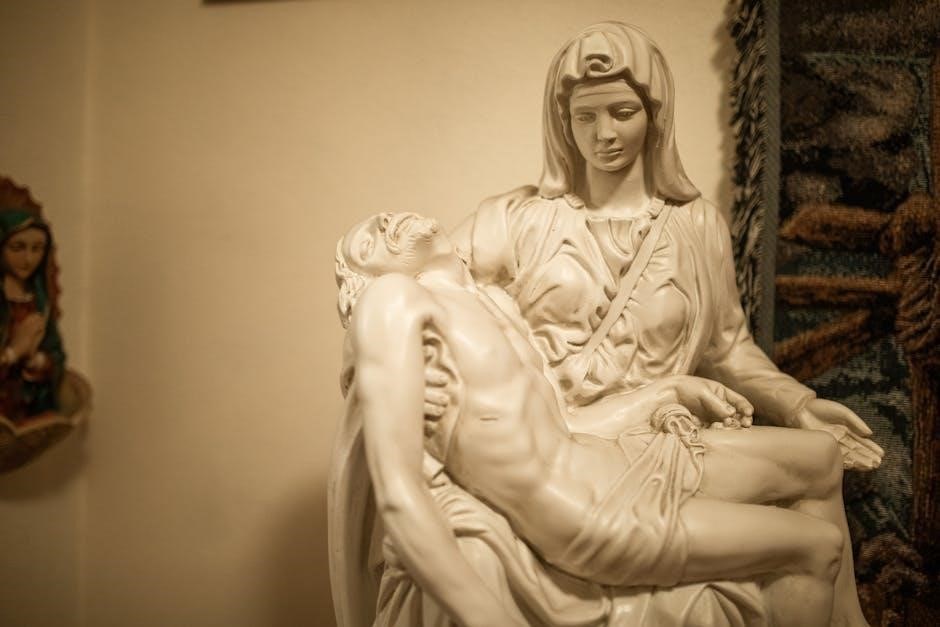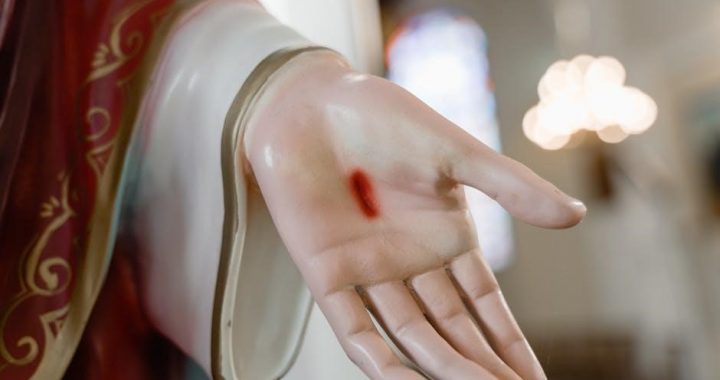The physical death of Jesus Christ has sparked intense debate and analysis across medical, theological, and cultural domains. The 1986 JAMA article, On the Physical Death of Jesus Christ, ignited controversy, with protests over its scientific examination of the Gospels. Meanwhile, films like Mel Gibson’s The Passion of the Christ visually depicted the crucifixion, drawing parallels to historical and medical studies. This topic bridges faith, history, and science, offering a profound exploration of Jesus’ death and its enduring impact.
Overview of the Topic
The physical death of Jesus Christ is a subject of profound interest, blending medical, historical, and theological perspectives. The 1986 JAMA article, On the Physical Death of Jesus Christ, sparked widespread debate by examining the crucifixion through a medical lens. This analysis, alongside biblical accounts and Roman crucifixion practices, provides a comprehensive understanding of the event. The topic also explores the physiological effects of crucifixion, shedding light on the cause of Jesus’ death. Additionally, it delves into the theological implications, such as the significance of the resurrection and the atonement theory. Cultural influences, including art, film, and literature, further highlight the enduring impact of this event. By integrating these diverse angles, the discussion offers a holistic view of Jesus’ death, bridging faith, history, and science.
Significance of “The Physical Death of Jesus Christ” PDF
The PDF, stemming from the 1986 JAMA article, bridges medical science and theology, offering a unique perspective on Jesus’ crucifixion. Its significance lies in sparking debates about the intersection of faith and science. The article’s publication led to emotional reactions, with protests over its scientific analysis of biblical accounts. It also influenced popular culture, such as Mel Gibson’s The Passion of the Christ, which visually depicted the crucifixion, aligning with historical and medical insights. The PDF remains a pivotal resource, challenging readers to consider the physiological and theological dimensions of Jesus’ death. Its interdisciplinary approach has made it a cornerstone for discussions on the crucifixion’s authenticity and its cultural impact, ensuring its relevance in both religious and academic circles.
Historical Context

The crucifixion of Jesus is deeply rooted in Roman execution methods, emphasizing public humiliation and pain. Biblical accounts and historical records highlight its brutal efficiency, shaping its enduring historical significance.

Biblical Accounts of Jesus’ Crucifixion
The biblical accounts of Jesus’ crucifixion, as detailed in the four Gospels (Matthew, Mark, Luke, and John), provide a vivid narrative of the events leading to His death. These accounts describe Jesus being nailed to a cross, enduring physical suffering, and ultimately succumbing to death. The Gospels highlight key moments, such as the piercing of His side with a spear and the flow of blood and water, which have been medically interpreted as evidence of cardiac rupture. The crucifixion is portrayed as a divine act of sacrifice, fulfilling Old Testament prophecies. The PDF, On the Physical Death of Jesus Christ, examines these biblical descriptions in light of medical and historical knowledge, offering a unique intersection of faith and science.
Roman Crucifixion Practices
Roman crucifixion was a brutal and public form of execution, designed to deter rebellion and instill fear. Victims were typically nailed or tied to a cross, often after being flogged. The process was slow and agonizing, with the crucified enduring intense pain, dehydration, and asphyxiation. The Romans perfected this method, using vertical and horizontal beams to maximize suffering. Crucifixion was reserved for slaves and non-Romans, emphasizing its dehumanizing nature. The practice was systematic, with soldiers ensuring the victim’s death was prolonged. Historical records and archaeological findings confirm the horrific details of this execution method, which was central to Jesus’ death as described in the Gospels. The 1986 JAMA article and other studies have analyzed the physiological effects of such practices, aligning with biblical accounts of Jesus’ crucifixion.

The 1986 JAMA Article on Jesus’ Death

The 1986 article, On the Physical Death of Jesus Christ, published in the Journal of the American Medical Association (JAMA), sparked significant controversy and debate. Authored by medical professionals, the article provided a detailed analysis of the crucifixion process, examining the physiological effects and likely cause of Jesus’ death. It suggested that asphyxiation, rather than blood loss, was the primary cause of death. The article also explored the medical plausibility of the Gospel accounts, drawing both praise for its scientific rigor and criticism for its perceived challenge to religious beliefs. The publication led to widespread discussions, with some religious groups protesting its release. Despite the backlash, the article remains a landmark study, bridging the gap between medical science and theological narratives surrounding Jesus’ crucifixion.

Medical Analysis

The 1986 JAMA article examined crucifixion’s physiological effects, detailing extreme stress, blood loss, and asphyxiation. Medical experts verified the Gospels’ accounts, concluding crucifixion caused Jesus’ death through cardiac arrest.
Methods of Crucifixion
Crucifixion, as a method of execution, involved severe physical suffering and was designed to prolong death. The Romans typically used a wooden cross, where the victim’s hands and feet were nailed to the structure. This method caused intense pain and led to eventual asphyxiation as the body’s weight strained the diaphragm, making breathing difficult. The cross was often elevated to expose the victim publicly, further humiliating them. Historical accounts and the 1986 JAMA article detail how the nails, often placed in the wrists and ankles, caused significant blood loss and nerve damage. The physical toll of crucifixion was immense, leading to exhaustion, dehydration, and eventual organ failure. These practices were meticulously documented in the JAMA article, providing a medical perspective on the brutality of this ancient execution method.
Physiological Effects of Crucifixion
Crucifixion inflicted extreme physical suffering, leading to severe physiological trauma. The method caused asphyxiation, as the victim’s diaphragm was unable to expand due to the position of the body. Blood loss from nail wounds and flogging led to hypovolemic shock, while the crucifixion itself caused cardiac distress. The weight of the body pulling downward made breathing increasingly difficult, eventually leading to respiratory failure. Additionally, the crucified individual experienced intense pain from nerve damage and muscle fatigue. These physiological effects, combined with dehydration and exposure, accelerated the onset of death. The 1986 JAMA article detailed these medical aspects, providing a scientific perspective on the suffering endured during crucifixion. This analysis aligns with historical accounts, offering a comprehensive understanding of the physical toll of this execution method.
Cause of Death
The primary cause of Jesus’ death was determined to be asphyxia, resulting from the physical strain of crucifixion. Medical analysis suggests that the positioning on the cross led to inadequate breathing, with the diaphragm unable to expand properly. This, combined with hypovolemic shock from blood loss, created a lethal combination. The crucifixion method caused severe trauma, including punctured lungs and a damaged heart, accelerating the process. The 1986 JAMA article highlighted these physiological effects, concluding that the combination of respiratory failure and cardiac arrest was the ultimate cause of death. This medical verification aligns with biblical accounts, providing a scientific explanation for the events described. The study’s findings have been widely referenced, offering a detailed understanding of the physical suffering endured during crucifixion.
Medical Verification of Crucifixion Details
The 1986 JAMA article, On the Physical Death of Jesus Christ, provided a medical analysis of crucifixion practices, verifying details from biblical accounts. It examined the physiological effects of scourging, the placement of nails, and the crucifixion cross’s structure. The study highlighted how prolonged exposure led to asphyxia and hypovolemic shock, aligning with descriptions of Jesus’ death. The article also explored the medical implications of the spear wound to Jesus’ side, confirming its consistency with cardiac tamponade and pericardial effusion. This medical verification bridged historical and scriptural narratives, offering a scientific perspective on the crucifixion’s brutality and its fatal consequences. The analysis remains a cornerstone in discussions about the physical death of Jesus, blending theology with medical science to enhance understanding of this pivotal event.
Theological Implications
The resurrection of Jesus is central to Christian faith, symbolizing victory over death and sin. The atonement theory underscores Jesus’ death as a redemptive act for humanity’s salvation, fulfilling divine purpose.

Significance of Jesus’ Resurrection
The resurrection of Jesus Christ is a cornerstone of Christian theology, symbolizing victory over death and sin. It is seen as a divine affirmation of Jesus’ mission and identity, providing hope for believers. The empty tomb and post-resurrection appearances, as described in the Gospels, are central to this belief. The resurrection underscores the idea of eternal life and redemption, making it a pivotal event in Christian faith. The PDF explores how the physical death of Jesus, verified through historical and medical analysis, lays the foundation for the theological significance of his resurrection. This event continues to inspire faith and spark debate, as seen in discussions surrounding its historical authenticity and spiritual implications. The resurrection remains a powerful symbol of transformation and renewal, deeply influencing Christian doctrine and personal belief systems worldwide.
The Atonement Theory
The Atonement Theory is central to Christian theology, positing that Jesus’ death was a sacrificial act to redeem humanity from sin. His crucifixion, as detailed in the PDF, symbolizes the ultimate act of divine love and forgiveness. The physical suffering Jesus endured, including the medical realities of crucifixion, underscores the gravity of this sacrifice. The theory emphasizes that Jesus’ death was not merely a historical event but a spiritual triumph, offering salvation to all. This doctrine is deeply intertwined with the resurrection, reinforcing the belief in eternal life. The PDF’s medical analysis of Jesus’ death provides a tangible foundation for understanding the theological significance of the Atonement, bridging faith and history.

Cultural Impact
The PDF’s analysis influenced art, film, and literature, sparking debates on Jesus’ death. Mel Gibson’s The Passion of the Christ visually depicted crucifixion, drawing parallels to historical and medical studies, fueling cultural and religious discussions globally.
Art and Symbolism
The physical death of Jesus Christ has profoundly influenced art and symbolism across centuries. Crucifixion scenes, often depicted in paintings and sculptures, emphasize the suffering and redemption central to Christian theology. The cross, a universal symbol of Christianity, represents both death and resurrection. In films like The Passion of the Christ, vivid portrayals of the crucifixion have reinforced its emotional and visual impact. Literary works frequently reference the crucifixion, using it as a metaphor for sacrifice and salvation. These depictions not only reflect historical accounts but also resonate deeply with cultural and spiritual beliefs. The imagery of Jesus’ death continues to inspire artistic expression, bridging the gap between faith and visual storytelling.
Film Depictions
Film depictions of Jesus’ crucifixion have played a significant role in shaping public perception of his death. Mel Gibson’s The Passion of the Christ (2004) is a prime example, vividly portraying the physical suffering and emotional toll of the crucifixion. The film’s release sparked widespread discussion, with many noting its graphic detail and historical accuracy. Rev. Wesley Gabel, who had previously studied Roman crucifixion practices, observed parallels between the film and his research. Such depictions not only highlight the brutality of crucifixion but also emphasize its theological significance. While films like Gibson’s are not documentaries, they serve as powerful tools for engaging audiences with the story of Jesus’ death, blending historical context with emotional resonance. These portrayals continue to influence how people visualize and reflect on the events leading to Jesus’ physical death.
Literary References
The physical death of Jesus Christ has been a recurring theme in literature, inspiring numerous works that explore its theological and historical significance. The 1986 JAMA article, On the Physical Death of Jesus Christ, has been referenced in various literary works, sparking debates about the intersection of faith and science. Literary analyses often delve into the crucifixion’s depiction in biblical narratives, comparing them with medical explanations. Some authors have used the PDF as a source to explore the psychological and physiological aspects of Jesus’ death, while others have critiqued its scientific approach to a deeply religious event. The topic has also appeared in fictional works, where it serves as a backdrop for exploring themes of sacrifice and redemption. These literary references highlight the enduring fascination with Jesus’ death and its multifaceted interpretations across genres and disciplines.

Conclusion
The PDF provides a comprehensive analysis of Jesus’ death, offering medical and theological insights. It has sparked significant dialogue, bridging faith and science in understanding this pivotal event.
Summary of Key Points
The physical death of Jesus Christ, as explored in the PDF, delves into the medical, historical, and theological aspects of His crucifixion. The 1986 JAMA article sparked controversy by examining the Gospels through a scientific lens, while films like The Passion of the Christ visually portrayed the event. Medical analyses highlight the physiological toll of crucifixion, including asphyxiation and blood loss. Theologically, Jesus’ death is central to the doctrine of atonement, while His resurrection remains a cornerstone of Christian faith. Culturally, the crucifixion has inspired countless works of art, literature, and film, cementing its enduring impact. This PDF bridges faith and science, offering a comprehensive understanding of Jesus’ death and its profound significance.
Reflection on the PDF’s Contribution
The PDF, On the Physical Death of Jesus Christ, has significantly contributed to bridging medical science and theology. Its publication in the Journal of the American Medical Association in 1986 sparked widespread debate, challenging traditional religious narratives while offering a scientific lens to understand Jesus’ crucifixion. The document’s meticulous analysis of physiological effects and historical crucifixion practices has made it a cornerstone for interdisciplinary discussions. It not only shed light on the medical aspects of Jesus’ death but also influenced cultural depictions, such as in films like The Passion of the Christ. By provoking both criticism and curiosity, the PDF has become a pivotal resource for scholars, theologians, and the general public, fostering a deeper understanding of the event’s historical and spiritual significance. Its impact continues to resonate, particularly during Easter reflections, where it offers a unique blend of science and faith.
